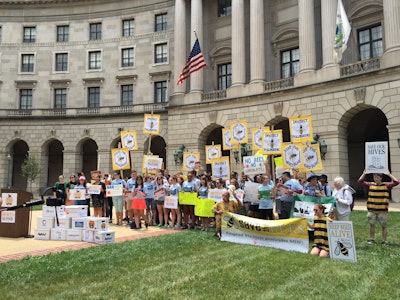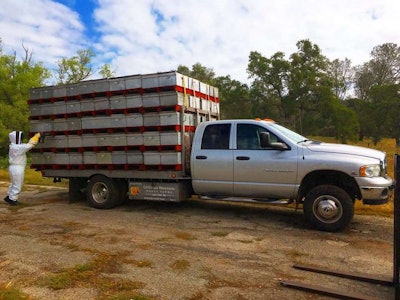 Activists rally outside of EPA’s headquarters to urge the banning of bee-toxic pesticides.
Activists rally outside of EPA’s headquarters to urge the banning of bee-toxic pesticides.Photo: Keep The Hives Alive Tour
National Pollinator Week was approved nine years ago, and to prove that bee health should still be a major concern for policymakers, activists arrived in Washington, D.C., this week with 2.64 million dead bees.
The Keep the Hives Alive Tour wrapped up its cross-country trek at the Environmental Protection Agency headquarters. The goal of the tour was to raise awareness of mass bee die-offs and the overall health of other pollinators.
 Before retiring this bee transport truck, it was decided to use it for the Keep the Hive Alive Tour.
Before retiring this bee transport truck, it was decided to use it for the Keep the Hive Alive Tour.Photo: Keep the Hive Alive Tour
Traveling in a truck full of dead bees, James Cook, a Minnesota beekeeper, has made stops in California, South Dakota, Minnesota, Michigan, Pennsylvania, and North Carolina. Cook participated in press conferences and panel discussions on his stops.
“I am doing this because I stood in a holding yard my first year beekeeping and witnessed a massive bee die-off as a result of seed treated corn being planted,” he told Friends of the Earth. “Fifteen hundred hives that spring had at least 50 percent of their adult bees die in front of me. As I work toward being a part of the next generation of beekeepers, I think it is imperative to talk about the issues I see happening around me.”
According a national survey, beekeepers lost 44 percent of their honey bee colonies from April 2015 to April 2016. This is the second year in a row that colony losses have exceeded 40 percent.
“The millions of dead bees that have accompanied us during the Keep the Hives Alive Tour are carrying a message – this is just a tiny fraction of the devastation beekeepers are dealing with year after year,” Larissa Walker, Center for Food Safety pollinator program director, said in a statement. “It’s well past time for policymakers to wake up and take action to curb the use of the toxic pesticides that are harming pollinators, people and our environment.”
 Tubs of dead bees on display in front of Bayer Crop Science’s North American Headquarters.
Tubs of dead bees on display in front of Bayer Crop Science’s North American Headquarters.Photo: Keep the Hives Alive Tour
Another organization that is trying to raise awareness this week is the Honey Bee Health Coalition, a group of nearly 40 organizations that focuses on creating healthy populations of bees and other pollinators.
This group is looking into a number of stressors that are harming bees. They state on their website, “There is no single cause of honey bee health decline.”
“What we know so far is that there are a handful of issues that can cause problems for bees,” said Carson Klosterman, a farmer and member of the National Corn Growers Association’s Production and Stewardship Action Team. “Severe weather, pests and disease, lack of forage and nutrition, lack of genetic diversity and incidental pesticide exposure may all be causing problems.”
Klosterman suggests fostering better communication among growers, applicators and beekeepers to help protect bees from unintended pesticide exposure.
The EPA determined in January that neonicotinoid imidacloprid can harm bees, but the agency has not proposed any official measures to restrict the pesticide as yet.









